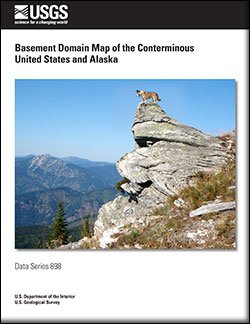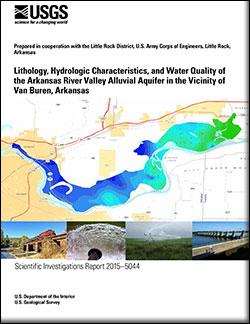Filters: Types: Citation (X) > Types: OGC WFS Layer (X) > partyWithName: U.S. Geological Survey (X)
536 results (81ms)|
Filters
Date Range
Extensions
Types
Contacts
Categories Tag Types
|
Region(s) of distribution of Arctic Sand Lance (Ammodytes hexapterus) Pallas, 1814 in the Arctic as digitized for U.S. Geological Survey Scientific Investigations Report 2016-5038. For details on the project and purpose, see the report at https://doi.org/10.3133/sir20165038. Complete metadata for the collection of species datasets is in the metadata document "Dataset_for_Alaska_Marine_Fish_Ecology_Catalog.xml" at https://doi.org/10.5066/F7M61HD7. Source(s) for this digitized data layer are listed in the metadata Process Steps section. Note that the original source may show an extended area; some datasets were limited to the published map boundary. Distributions of marine fishes are shown in adjacent Arctic seas...
Categories: Data;
Types: Citation,
Downloadable,
Map Service,
OGC WFS Layer,
OGC WMS Layer,
Shapefile;
Tags: Alaska,
Ammodytes hexapterus,
Arctic,
Arctic,
Arctic Sand Lance,
Migratory species provide ecosystem goods and services throughout their annual cycles, often over long distances. Designing effective conservation solutions for migratory species requires knowledge of both species ecology and the socioeconomic context of their migrations. We present a framework built around the concept that migratory species act as carriers, delivering benefit flows to people throughout their annual cycle that are supported by the network of ecosystems upon which the species depend. We apply this framework to the monarch butterfly (Danaus plexippus) migration of eastern North America by calculating their spatial subsidies. Spatial subsidies are the net ecosystem service flows throughout a species’...
Shapefile containing the boundary of the Northwest Climate Adaptation Science Center (CASC).
Categories: Data;
Types: Citation,
Downloadable,
Map Service,
OGC WFS Layer,
OGC WMS Layer,
Shapefile;
Tags: Climate Science Center,
Washington, Oregon, Idaho,
boundaries
Shapefile containing the boundary of the Alaska Climate Adaptation Science Center (CASC).
Categories: Data;
Types: Citation,
Downloadable,
Map Service,
OGC WFS Layer,
OGC WMS Layer,
Shapefile;
Tags: Alaska,
Climate Science Center,
boundaries
From 2013 to 2015, bathymetric surveys of New York City’s six West of Hudson reservoirs (Ashokan, Cannonsville, Neversink, Pepacton, Rondout, and Schoharie) were performed to provide updated capacity tables and bathymetric maps. Depths were surveyed with a single-beam echo sounder and real-time kinematic global positioning system (RTK-GPS) along planned transects at predetermined intervals for each reservoir. A separate set of echo sounder data was collected along transects at oblique angles to the main transects for accuracy assessment. Field survey data was combined with water-surface elevations in a geographic information system to create three-dimensional surfaces representing reservoir-bed elevations in the...
Categories: Data;
Types: Citation,
Downloadable,
Map Service,
OGC WFS Layer,
OGC WMS Layer,
Shapefile;
Tags: GPS measurement,
Rondout Reservoir,
Sullivan County,
Ulster County,
bathymetry,
From 2013 to 2015, bathymetric surveys of New York City’s six West of Hudson reservoirs (Ashokan, Cannonsville, Neversink, Pepacton, Rondout, and Schoharie) were performed to provide updated capacity tables and bathymetric maps. Depths were surveyed with a single-beam echo sounder and real-time kinematic global positioning system (RTK-GPS) along planned transects at predetermined intervals for each reservoir. A separate set of echo sounder data was collected along transects at oblique angles to the main transects for accuracy assessment. Field survey data was combined with water-surface elevations in a geographic information system to create three-dimensional surfaces representing reservoir-bed elevations in the...
Categories: Data;
Types: Citation,
Downloadable,
Map Service,
OGC WFS Layer,
OGC WMS Layer,
Shapefile;
Tags: Delaware County,
GPS measurement,
Pepacton Reservoir,
bathymetry,
single-beam echo sounder
The data for this release is an ASCII file containing grid points of Cascadia P- and S-wave velocity models. The model volume was developed to include the Cascadia subduction zone for purposes of ground motion simulation. The description of the model and background of its development is provided in the associated Open-File Report. The grid points are given in Universal Transverse Mercator (UTM) Zone 10 North coordinates for East and North locations, and the grid point depths are given in meters below mean sea level. Grid point spacing is 500 meters in each ordinal direction. The model region extends approximately from 40.2°N to 50°N latitude, and approximately from 122°W to 129°W longitude. The maximum depth of...
Region(s) of distribution of Starry Flounder (Platichthys stellatus) (Pallas, 1787) in the Arctic as digitized for U.S. Geological Survey Scientific Investigations Report 2016-5038. For details on the project and purpose, see the report at https://doi.org/10.3133/sir20165038. Complete metadata for the collection of species datasets is in the metadata document "Dataset_for_Alaska_Marine_Fish_Ecology_Catalog.xml" at https://doi.org/10.5066/F7M61HD7. Source(s) for this digitized data layer are listed in the metadata Process Steps section. Note that the original source may show an extended area; some datasets were limited to the published map boundary. Distributions of marine fishes are shown in adjacent Arctic seas...
Categories: Data;
Types: Citation,
Downloadable,
Map Service,
OGC WFS Layer,
OGC WMS Layer,
Shapefile;
Tags: (Pallas, 1787),
Alaska,
Arctic,
Arctic,
Beaufort Sea,
Region(s) of distribution of Polar Eelpout (Lycodes polaris) (Sabine, 1824) in the Arctic as digitized for U.S. Geological Survey Scientific Investigations Report 2016-5038. For details on the project and purpose, see the report at https://doi.org/10.3133/sir20165038. Complete metadata for the collection of species datasets is in the metadata document "Dataset_for_Alaska_Marine_Fish_Ecology_Catalog.xml" at https://doi.org/10.5066/F7M61HD7. Source(s) for this digitized data layer are listed in the metadata Process Steps section. Note that the original source may show an extended area; some datasets were limited to the published map boundary. Distributions of marine fishes are shown in adjacent Arctic seas where reliable...
Categories: Data;
Types: Citation,
Downloadable,
Map Service,
OGC WFS Layer,
OGC WMS Layer,
Shapefile;
Tags: (Sabine, 1824),
Alaska,
Arctic,
Arctic,
Beaufort Sea,
Region(s) of distribution of Broad Whitefish (Coregonus nasus) (Pallas, 1776) in the Arctic as digitized for U.S. Geological Survey Scientific Investigations Report 2016-5038. For details on the project and purpose, see the report at https://doi.org/10.3133/sir20165038. Complete metadata for the collection of species datasets is in the metadata document "Dataset_for_Alaska_Marine_Fish_Ecology_Catalog.xml" at https://doi.org/10.5066/F7M61HD7. Source(s) for this digitized data layer are listed in the metadata Process Steps section. Note that the original source may show an extended area; some datasets were limited to the published map boundary. Distributions of marine fishes are shown in adjacent Arctic seas where...
Categories: Data;
Types: Citation,
Downloadable,
Map Service,
OGC WFS Layer,
OGC WMS Layer,
Shapefile;
Tags: (Pallas, 1776),
Alaska,
Arctic,
Arctic,
Beaufort Sea,
This data release includes vertical offset information for the regionally extensive Main Terrace in the Lower Rhine Graben in the border region between Germany, Beligum, and Netherlands.
Categories: Data;
Types: Citation,
Map Service,
OGC WFS Layer,
OGC WMS Layer,
OGC WMS Service;
Tags: Belgium,
Geomorphology,
Germany,
Lower Rhine,
Netherlands,
The travel time map was generated using the Pedestrian Evacuation Analyst model from the USGS. The travel time analysis uses ESRI's Path Distance tool to find the shortest distance across a cost surface from any point in the hazard zone to a safe zone. This cost analysis considers the direction of movement and assigns a higher cost to steeper slopes, based on a table contained within the model. The analysis also adds in the energy costs of crossing different types of land cover, assuming that less energy is expended walking along a road than walking across a sandy beach. To produce the time map, the evacuation surface output from the model is grouped into 1-minute increments for easier visualization. The times in...
Categories: Data;
Types: Citation,
Downloadable,
Map Service,
OGC WFS Layer,
OGC WMS Layer,
Shapefile;
Tags: Humboldt County,
evacuation,
hazard preparedness,
hazards,
tsunamis,
Fire can be a significant driver of permafrost change in boreal landscapes, altering the availability of soil carbon and nutrients that have important implications for future climate and ecological succession. However, not all landscapes are equally susceptible to fire-induced change. As fire frequency is expected to increase in the high latitudes, methods to understand the vulnerability and resilience of different landscapes to permafrost degradation are needed. Geophysical and other field observations reveal details of both near-surface (less than 1 m) and deeper (greater than 1 m) impacts of fire on permafrost along 14 transects that span burned-unburned boundaries in different landscape settings within interior...
Categories: Data;
Types: Citation,
Downloadable,
Map Service,
OGC WFS Layer,
OGC WMS Layer,
Shapefile;
Tags: Active layer thickness,
Alaska,
Borehole nuclear magnetic resonance,
Chatanika,
City of Fairbanks,
These digital maps are a reformulation of previously published maps, primarily maps of states. The reformulation gives all the maps the same structure and format, allowing them to be combined into regional maps. The associated data tables have information about age and lithology of the map units, also in a standard format.
Categories: Data;
Types: Citation,
Downloadable,
Map Service,
OGC WFS Layer,
OGC WMS Layer,
Shapefile;
Tags: Arizona,
USA,
geologic age,
geology,
lithology,
Brackish groundwater (BGW), defined for this assessment as having a dissolved-solids concentration between 1,000 and 10,000 milligrams per liter is an unconventional source of water that may offer a partial solution to current (2016) and future water challenges. In support of the National Water Census, the U.S. Geological Survey has completed a BGW assessment to gain a better understanding of the occurrence and character of BGW resources of the United States as an alternative source of water. Analyses completed as part of this assessment relied on previously collected data from multiple sources, and no new data were collected. One of the most important contributions of this assessment is the creation of a database...
Categories: Data;
Types: Citation,
Downloadable,
Map Service,
OGC WFS Layer,
OGC WMS Layer,
OGC WMS Service;
Tags: Alaska,
American Samoa,
Guam,
Hawaii,
Puerto Rico,

Categories: Publication;
Types: Citation,
Map Service,
OGC WFS Layer,
OGC WMS Layer,
OGC WMS Service;
Tags: Data Series

Categories: Publication;
Types: Citation,
Map Service,
OGC WFS Layer,
OGC WMS Layer,
OGC WMS Service;
Tags: Scientific Investigations Report
In 2013, the first of several Regional Stream Quality Assessments (RSQA) was done in the Midwest United States. The Midwest Stream Quality Assessment (MSQA) was a collaborative study by the U.S. Geological Survey (USGS) National Water Quality Assessment (NAWQA), the USGS Columbia Environmental Research Center, and the U.S. Environmental Protection Agency (USEPA) National Rivers and Streams Assessment (NRSA). One of the objectives of the RSQA, and thus the MSQA, is to characterize the relationships between water-quality stressors and stream ecology and to determine the relative effects of these stressors on aquatic biota within the streams (U.S. Geological Survey, 2012). To meet this objective, a framework of fundamental...
Categories: Data;
Types: Citation,
Downloadable,
Map Service,
OGC WFS Layer,
OGC WMS Layer,
Shapefile;
Tags: Ecoregions,
Geographic Information Systems,
Geospatial Analysis,
Geospatial Datasets,
Illinois,
The purpose of this report is to explore current oil and gas energy development in the area encompassing the Wyoming Landscape Conservation Initiative. The Wyoming Landscape Conservation Initiative is a long-term science-based effort to ensure southwestern Wyoming’s wildlife and habitat remain viable in areas facing development pressure. Wyoming encompasses some of the highest quality wildlife habitats in the Intermountain West. At the same time, this region is an important source of natural gas. Using Geographic Information System technology, energy data pertinent to the conservation decision-making process have been assembled to show historical oil and gas exploration and production in southwestern Wyoming....
Categories: Publication;
Types: Citation,
Map Service,
OGC WFS Layer,
OGC WMS Layer,
OGC WMS Service,
Report Citation;
Tags: energy,
energy development
Fire can be a significant driver of permafrost change in boreal landscapes, altering the availability of soil carbon and nutrients that have important implications for future climate and ecological succession. However, not all landscapes are equally susceptible to fire-induced change. As fire frequency is expected to increase in the high latitudes, methods to understand the vulnerability and resilience of different landscapes to permafrost degradation are needed. Geophysical and other field observations reveal details of both near-surface (less than 1 m) and deeper (greater than 1 m) impacts of fire on permafrost along 14 transects that span burned-unburned boundaries in different landscape settings within interior...
Categories: Data;
Types: Citation,
Map Service,
OGC WFS Layer,
OGC WMS Layer,
OGC WMS Service;
Tags: Active layer thickness,
Alaska,
Borehole nuclear magnetic resonance,
Chatanika,
City of Fairbanks,
|

|